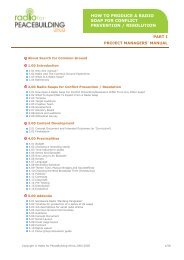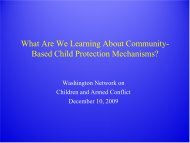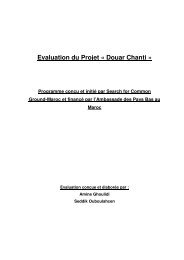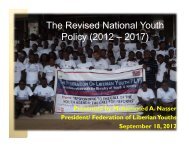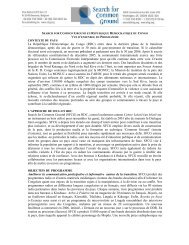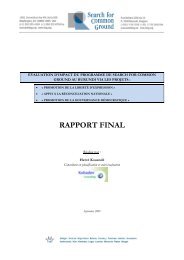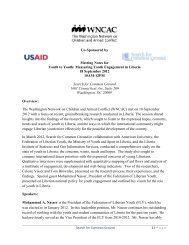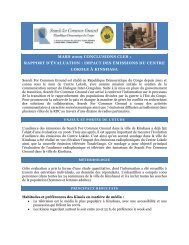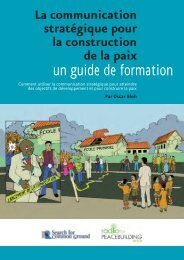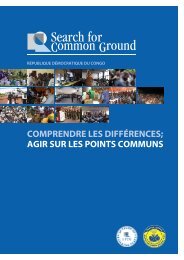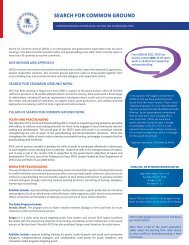The Common Ground Network for Life and Choice Manual
The Common Ground Network for Life and Choice Manual
The Common Ground Network for Life and Choice Manual
Create successful ePaper yourself
Turn your PDF publications into a flip-book with our unique Google optimized e-Paper software.
Appendix 6.1<br />
On-Line Dialogue<br />
Dear Prospective Participant,<br />
You have expressed interest in participating in our e-mail dialogue group. <strong>The</strong> goal <strong>for</strong> this group is to engage in<br />
dialogue about the conflict surrounding abortion using the common ground approach. In this e-mail message, we<br />
hope to give you a better underst<strong>and</strong>ing of who we are <strong>and</strong> what the process will look like, as well as provide some<br />
practical in<strong>for</strong>mation about how our -e-mail dialogue group will work. At the end of this letter you will find some<br />
basic ground rules which are designed to ensure a safe space <strong>for</strong> dialogue. <strong>The</strong> letter is rather long, but your<br />
patience <strong>and</strong> care in reading it will ensure that you reach a full underst<strong>and</strong>ing of the nature <strong>and</strong> expectations of the<br />
group. If you are still interested in participating after reading the letter, send a return message acknowledging the<br />
terms, <strong>and</strong> be sure to save this letter in your files <strong>for</strong> future reference<br />
Who are we?<br />
<strong>The</strong> <strong>Network</strong> <strong>for</strong> <strong>Life</strong> <strong>and</strong> <strong>Choice</strong> promotes <strong>and</strong> assists dialogue <strong>and</strong> joint action between pro-choice <strong>and</strong> pro-life<br />
adversaries in the abortion debate. <strong>The</strong> <strong>Network</strong> is a project of the independent, non-profit organization Search <strong>for</strong><br />
<strong>Common</strong> <strong>Ground</strong>, based in Washington, DC <strong>and</strong> founded in 1982 to find workable solutions to divisive national<br />
<strong>and</strong> international problems. <strong>The</strong> <strong>Network</strong> began in 1993 after Search was challenged by the Buffalo Council of<br />
Churches to apply the approaches it was using in the Middle East, Russia <strong>and</strong> Eastern Europe to bring opponents on<br />
the abortion issue into constructive conversation in the wake of a polarizing Operation Rescue Campaign. Since the<br />
first pilot ef<strong>for</strong>t in Buffalo in 1993, the <strong>Network</strong>'s goal has been to change the dynamic of the conflict by opening<br />
new channels of communication <strong>and</strong> encouraging the resulting relationships into constructive directions. If you<br />
would like to learn more about the activities of Search <strong>for</strong> <strong>Common</strong> <strong>Ground</strong>, you can do so by accessing our web<br />
page at http://www.search<strong>for</strong>commonground.org.<br />
What is the "<strong>Common</strong> <strong>Ground</strong> Approach"?<br />
<strong>The</strong> common ground approach enables people who disagree to put a human face on their opponents <strong>and</strong> to search<br />
<strong>for</strong> the common ground they have with one another. <strong>The</strong>y do not compromise their views, nor do they try to<br />
convince those with differing views to change them. Rather, those who search <strong>for</strong> common ground try to<br />
underst<strong>and</strong> one another's viewpoints <strong>and</strong> the reasons that lead each person to hold the convictions they do, <strong>and</strong> to<br />
identify points of connection <strong>and</strong> shared concerns.<br />
<strong>The</strong> common ground approach is a process of breaking down the communication barriers that have been built up<br />
through the course of the conflict. This allows persons on opposing sides to explore areas where the beliefs, values,<br />
<strong>and</strong> concerns of both sides overlap. <strong>The</strong>re<strong>for</strong>e, the common ground approach can be a process by which people on<br />
both sides can work in partnership on problems <strong>and</strong> issues that are important to them both.<br />
Our approach can be captured in several key points:<br />
• Dialogue vs. Debate: Instead of carrying on a debate, which creates winners <strong>and</strong> losers <strong>and</strong> leads to pain <strong>and</strong><br />
division, we focus on dialogue leading to greater underst<strong>and</strong>ing <strong>and</strong> trust.<br />
• Continuum: A common ground approach assumes that even in a polarized conflict, people’s views fall on a<br />
continuum. When people identify themselves as “pro-choice” or “pro-life,” they are placing themselves<br />
somewhere on the continuum other than the exact center. <strong>The</strong> idea of a continuum encourages awareness of<br />
how little we can assume about another person’s set of beliefs, if all we know about them is that they choose<br />
one label over the other.



